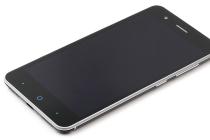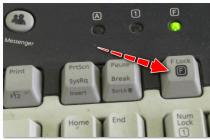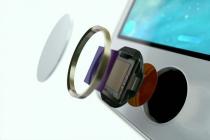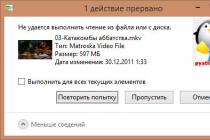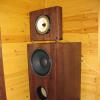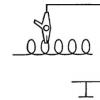The working surface of optical discs is easily damaged - the protective layer is covered with scratches even with moderate use. Deep defects often lead to the impossibility of extracting information from a damaged medium. Next, we will tell you how to restore a scratched disc by polishing with toothpaste, GOI paste, and also consider some "harmful" tips from the Network for resuscitation of compacts.
Handling damaged optical discs
We must say right away that an unreadable medium with deep scratches can be restored in this way, at best, only partially. Moreover, you will have to act very carefully, otherwise the surface can be completely spoiled. It would be better to first practice on old unnecessary media before restoring a disc with valuable information - this way you can evaluate the effectiveness of the method and, as they say, fill your hand.
And do not try to immediately resort to using the method described below when a reading error occurs - check the disc on another computer - it is often the DVD drive that is the cause of the problems. In addition, there are many applications that allow you to extract the most information from scratched discs thanks to a modified reading algorithm. One of the most effective solutions is Durable Copy.
It is also advisable to use the program to work with discs that have already been restored by polishing, because we have already noted that severely damaged media can never be reanimated 100%.
How to polish a disc with toothpaste at home
The most affordable and safest way to polish is with toothpaste:

The movements during the polishing process should not be too intense, so that the surface does not heat up quickly. You don't need to put pressure on the disc either. After 15-20 minutes, rinse the disc thoroughly in warm water. Its surface can become dull due to the appearance of many microscopic scratches, but deep damage will become much less noticeable, which should affect the readability of the disc for the better.
Dry your optical drive, try inserting it into your DVD drive. If your goal is to extract photos, important documents, etc., use Durable Copy or similar. Surely there will be much more undamaged information copied this time.
If necessary, the restoration of the working surface using the method described above can be repeated, but it makes sense to carry it out for no more than an hour. As practice shows, too long polishing with a paste already causes the opposite effect - the readable data on the carrier becomes less.
Professional polishing method
For really valuable and expensive discs, you should no longer use such artisanal methods. To obtain an acceptable result, the polycarbonate base will need to be polished with a fine abrasive GOI paste (sold in hardware stores) using an electric drill with a grinding attachment:

If you do not have a power tool, polishing with GOI paste can also be done manually, but a positive result is far from guaranteed, and the process can be very delayed.
How not to recover optical discs
You can often read a lot of alternative methods for recovering scratched CDs on the Internet. For example, sometimes it is advised to polish with just a soft or denim cloth. It is clear that you cannot polish the surface with non-abrasive materials. It will simply overheat and the media will no longer be recoverable.
Another extreme option (real advice from "experts" from the Web) is polishing with fine-grained sandpaper. In this way, you can immediately ruin the surface without even exerting effort. The same applies to heating the disc in the microwave, under a table lamp, etc.
Another popular advice from the Internet is to cover the scratch with "brilliant green" or even completely treat the surface of the compact with it.

The CD may be scratched from rough handling or dropping. Scratches and dirt on the disc surface can lead to errors in reading the disc or prevent it from playing at all, since any defects on its surface prevent the drive's laser beam from reading the data. Fingerprints and other dirt can be easily removed from the disc surface, but with scratches, everything is much more complicated. Not only does a scratch prevent the laser from reading the data, but if it is deep enough, it can damage the reflective coating of the disc that contains the data. If only the polycarbonate cover is scratched and the metal layer is intact, the disc can be repaired.
How to clean a scratched disc
Clean the disc so you can see the scratches. Grasp the disc by the edges, wash it with soap and water and pat dry with a soft towel (do not rub it so as not to scratch it). Also, light dirt can be removed with a soft cloth slightly dampened with water. Wipe the disc from the inside to the outside. Sometimes this is enough for the disc to start playing again.
Examine the blank disc carefully under good lighting. Scratches that may affect disc playback run parallel to the edge of the disc. Vertical scratches that run from the center to the edge of the disc are usually not a problem.
Place the disc on a flat surface with the label facing down, while it should not be too rough, as the top of the disc is covered with a thin layer of protective varnish, which can also be damaged.
To remove scratches from a disc, you need to carefully polish its protective coating using a soft cloth and a small amount of a very mild abrasive, such as plain white toothpaste or furniture polish. Do not use the same cloth that you used to clean the disc, as some residues of dirt can get stuck in the fibers, resulting in even more scratches. Also, do not use a cloth with an abrasive surface. For minor scratches, toothpaste is an effective solution. For deeper scratches, a polish will work, but keep in mind that polishing too hard can lead to new scratches.
So, apply a small amount of toothpaste or polish to a cotton swab. If you apply a lot of substance, the polishing will be more difficult. Lightly rub the swab over the scratch until the scratch is gone. Start moving from the center of the disc to its edge. Scratches lend themselves best to polishing along their length. Thus, any scratches you accidentally make will be harmless (vertical type). After that, clean the disc with alcohol or glass cleaner and a clean cloth to remove the remaining polish, let it dry and try to play it again. If the disc still does not play, repeat the procedure.
Furniture wax or car wax can also be used for large scratches.... Apply wax all over the disc and buff with a cloth. Use a lint-free cloth. Instead of removing scratches, wax fills in the gaps between them.
Also, do not forget that you can buy polishing kits from shops to restore scratched or damaged CDs.
If the scratch is particularly deep, the data layer may be damaged, rendering the disc defective. In this case, polishing will not help.
Different waxes and polishes can lead to different results. Experiment with furniture wax, liquid car wax, and other materials. Try material on an unwanted or blank disc before attempting to recover a valuable disc.
Never wipe the disc in a circular motion, as this can damage the disc and in fact do more damage.
Probably everyone met with the problem of a scratched disk,
For example, in the middle of Installing a game or watching a movie, an error appears.
Many do not even think that it can still be restored and your game will be installed ..
I advise everyone to read this article, Even if you don't have a scratched disc.
The CD may be scratched from rough handling or dropping.
Scratches and debris on the surface of the disc can cause disc read errors,
Or prevent its reproduction altogether, since any defects on it
Surfaces interfere with the drive's laser beam from reading the data.
Fingerprints and other dirt can be easily removed from the surface of the disc,
But with scratches, everything is much more complicated.
A scratch not only prevents the laser from reading the data,
But also, if deep enough, it can damage the reflective coating of the disc,
Which contains the data.
The disc is coated on top with a polycarbonate coating.
If only it is scratched and the metal layer is not damaged,
then the disk can be recovered.
How to clean a disc of minor scratches:
To clean small scratches, you need cotton wool and cologne.
Grasp the disc by the edges and squirt the cologne several times.
And wipe the disc with cotton, starting from the center to the edge - but not in a circular motion!
Sometimes this is enough for the disc to start playing again.
How to clean a medium scratch disc:
To remove scratches from the disc, you need to carefully polish its protective coating,
using cotton wool and a small amount of a very mild abrasive,
for example, plain white toothpaste or furniture polish.
So, apply a small amount of toothpaste to the scratch on the disc.
If you apply a lot of substance, the polishing will be more difficult.
Rub the cotton over the scratch without applying any extra effort until
until the scratch is gone. Start moving from the center of the disc to its edge.
Scratches lend themselves best to polishing along their length. 
After that, clean the disc with cologne (popping it onto the disc and rubbing new cotton wool)
And try to play it again.
If the disc still does not play, repeat the procedure.
Personally, I had a disk with Windows 7 and an error occurred at the beginning of the installation.
After three attempts to clean the scratches with toothpaste, the installation began to reach the middle.
Then, after cleaning 4 more times, windows was installed.
And don't think: "What did the author smoke?" This method really works.
For minor scratches, toothpaste is an effective solution.
For deeper scratches, a polish is fine, but remember
that too much force during polishing can lead to new scratches.
For big scratches you can also use furniture wax or car wax.
Apply wax all over the disc and buff with a cloth.
Use a lint-free cloth. Instead of removing scratches
the wax will fill in the gaps between them.
Also, do not forget that you can buy polishing kits in stores.
For recovering scratched or damaged CDs.
If the scratch is particularly deep, the data layer may be damaged,
which makes the disk fail. In this case, polishing will not help.
Tips and Warnings:
If you would like to experiment with other waxes or materials,
Then do it on an unnecessary disc - as it is possible that the wax will not come off.
It is very difficult to keep the rims intact. They are constantly exposed to external influences that negatively affect the surface. This causes scratches and chips. Many drivers often ask the question, how can scratches be removed from a disc? Today this has become possible thanks to the latest coating restoration technologies.
Repair features
To restore the coating and remove scratches, you must first study the nature of their occurrence. For example, working with forged products is much more difficult than handling alloy wheels. To achieve a good result, it is best to seek professional help.
Models made in the USA, Japan and European countries are perfectly repaired. A variety of techniques are used to repair a scratched disc:
- You can use the method of polishing the top coat.
- Partially paint over the damaged metal surface.
- Set brand emblems on brand samples.
- Use special spare parts.
- Apply alternative methods of removing visual scratches.
Disc polishing is very popular, after which scratches are completely removed. However, this technique does not always help. If the depth of the scratch reaches the metal, it will not be possible to remove it by polishing. More complex work will be required. Fortunately, modern technology makes it possible to fully recover any disk.
The CD may be scratched from dropping or rough handling. Dirt and scratches on the surface of discs lead to read errors or even interfere with disc playback, because any defects on the surface of the disc prevent the drive's laser beam from reading information normally. Fingerprints and other dirt can be easily cleaned from the surface of the disc, but scratches are much more difficult to deal with. In addition to the fact that scratches prevent the laser from reading information from the disc, if they are deep, then there is a possibility that they will damage the reflective coating of the disc where the information is stored. If the metal layer is not damaged, but only the polycarbonate coating is affected, then this disc may be restored.
Cleaning discs from scratches
First clean the disc so that you can see any scratches. To do this, wash the disc with soap and dry it with a soft towel (do not scratch the disc while wiping it). Light dirt can also be cleaned with a damp soft cloth. Start wiping the disc from the center outward. In some cases, this is enough for the disc to start playing again.Next, you need to carefully examine the clean disc under good lighting. Disc playback may be affected by scratches that run parallel to the edge of the disc. Scratches that run from the edge of the disc to the center are usually not a problem.
Place the disc, label side down, on a flat surface. The surface should not be very rough, because on top of the disc there is too thin a layer of protective varnish, which can also be damaged.
To remove scratches from a disc, gently polish the protective coating on it using a soft cloth and a mild abrasive. You can use furniture polish or white toothpaste. The cloth that you used to clean the disc from dirt should not be used, because it may have residues of dirt, which can further scratch the disc. For scratches you can use toothpaste, but for deeper scratches it will be better to use a polish, but when polishing it is not necessary to exert too much effort, because you can scratch the disc.
You need to put a little polish or toothpaste on a cotton swab, polishing will be much more difficult if you apply a lot of polish. Rub the swab lightly over the scratch until it disappears. Buff the disc from the center to the edge. Then clean it with glass cleaner or alcohol and a clean cloth. After the disc is dry, try to play it again, if it still does not play, then repeat the procedure.
You can also use car wax or furniture wax for larger scratches. The entire disc should be waxed and polished with a lint-free cloth. The wax does not remove scratches, but fills in the gaps.
Stores also sell special polishing kits for repairing damaged or scratched CDs.
The disc is 100% damaged and nothing will save it if the scratch is very deep and the data layer is damaged.




